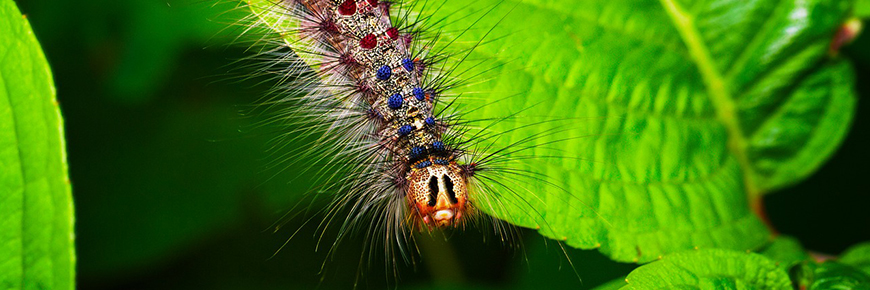
Lymantria dispar dispar (LDD) moth
Rouge National Urban Park
The Lymantria dispar dispar (LDD) moth is a non-native moth species, originally from western Europe and introduced in 1869, now widespread in Ontario and large portions of eastern Canada and the United States. The natural lifecycle of the LDD moth includes periodic population booms every 5 to 10 years, lasting from 1 to 3 years.
Why are LDD moths problematic?
How can I identify the LDD moth?
Egg – late August to early May

LDD moth eggs remain dormant while gathered in tight, light brown, spongy-looking groupings called egg masses. These egg masses are typically laid on the bark of trees, often (but not always) close to the ground, as well as on other objects like lawn furniture and playground equipment. The eggs remain protected in these masses until spring when the weather begins to warm and they hatch hundreds of caterpillars.
Caterpillar (Larva) – early May to mid-July
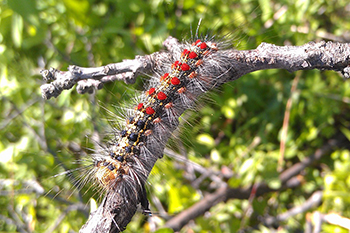
LDD moth caterpillars hatch at about 0.5cm in length and shed their “skin” (or exoskeleton) three to four times, growing up to 5-6cm at their largest stage (“instar”). The caterpillars are dark and covered in many tiny hairs, making them look furry. In the later period of this instar, pairs of red and blue dots are visible on their backs. When the caterpillars hatch from their eggs, they are small enough to be carried on a silk strand in the wind up to 1km from where they hatched. When the caterpillars have reached their final size, after up to seven weeks of eating, they seek a sheltered spot to produce their cocoon.
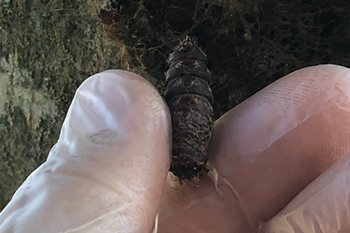
Cocoon (Pupa) – mid-July to early August
In the cocoon (pupa) stage, the LDD moth is dark reddish-brown in colour and can usually be found in large clumps of other cocoons and a silk web, spun during the caterpillar stage. These clumps are usually found in crevices on tree bark or on the underside of branches at the trunk, though like the egg masses they may be found in many different places in outbreak years.
Moth – late July to late August
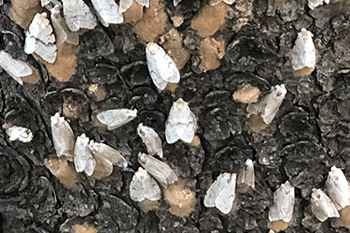
The adult stage of the LDD moth is relatively short-lived compared to the other life stages as neither the male or female adult moths eat when they emerge from their cocoons. Their only purpose is to reproduce. The female moths are larger than the males and are cream coloured while the males are smaller and light brown in colour. The female LDD moth cannot fly, so it will wait on the bark of a tree and attract males using pheromones. The moths live for approximately two weeks and the egg masses remain until hatching the following year, reinitiating the life cycle.
What is Parks Canada doing about LDD moths?
- partnering with the York Region in an egg mass count;
- completing defoliation inventories of selected forested zones in the park, including areas adjacent to the City of Pickering;
- communicating information to park residents and neighbours; and
- protecting select trees of cultural and historical importance by manually removing egg masses and burlap banding these trees for the removal of caterpillars.
Parks Canada will continue egg mass counts and tree defoliation and recovery monitoring in support of decision-making regarding current and future LDD moth management activities.
Typically, the LDD moth population is cyclical, meaning that some years there are very few caterpillars, and other years, like the one we are currently experiencing, the population numbers are extremely high. There are various natural factors that reduce established LDD moth populations over time and keep them in check. These include the soil fungus Entomophaga maimaiga and the nuclear polyhedrosis virus (NPV) which infects and kills the caterpillars. Natural predators, such as birds, and extreme cold weather can also reduce LDD moth populations.
These natural factors are very important in mitigating any long-term impacts to tree populations in RNUP. However, Parks Canada is monitoring impacts and taking action where necessary to protect the natural and cultural heritage of the park.
Why isn’t Parks Canada spraying the forests in Rouge National Urban Park to reduce the impact of the LDD moth?
Parks Canada takes its conservation mandate very seriously and will not engage in broadscale application of Btk within Rouge National Urban Park to avoid damaging native, and endangered or rare, caterpillar populations, such as the Monarch butterfly, which we are mandated to protect and impairing natural forest cycles.
Fortunately, healthy trees can typically withstand multiple years of defoliation by LDD moth caterpillars before being impacted in the long-term. The LDD moth population is cyclical in nature, so the most intense years of infestation are typically short-lived before the population recedes. This means that LDD moth populations in large forested areas are likely to be controlled by their own cycle and in combination with cool, wet springs, without requiring human intervention.
How do I protect vegetation on my property?
The following are some of the control practices that are effective in mitigating the negative impacts of LDD moth caterpillars. Note: Always wear protective gloves and glasses when removing LDD moth caterpillars since their hairs can cause skin irritation or allergies.
Year-round
To minimize the spread of LDD moth to other trees Parks Canada encourages property owners to limit movement of firewood, which can be infested with eggs or larvae, and to proactively manage overgrowth on backyard trees and plants to reduce the amount of leaf surface area on which moth caterpillars can thrive.
Burlap Banding – Early May to September
Supplies:
- Burlap fabric
- Twine or string
- Flat, rigid object for scraping, like a credit card or paint scraper
- Container of soapy water
Instructions:
- Wrap burlap fabric around the trunk of the moth-infested tree.
- Tie twine or string around the burlap just below the centre of the fabric.
- Allow the fabric to drape over the twine, creating a sheltered area where caterpillars will hide during the day.
- Check the underside of the burlap for any caterpillars each afternoon.
- Scrape any caterpillars into a container of soapy water and leave them for 48 hours to ensure they are destroyed.
- Drain the water down a sink and discard the caterpillars in the compost, green bin or garbage.

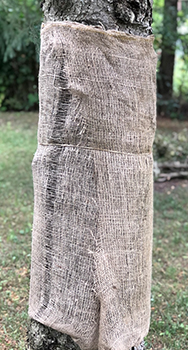
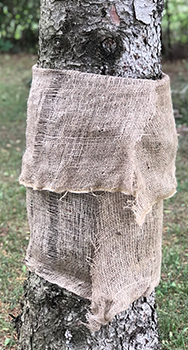
Hand Picking – May to August
Supplies:
- Container of soapy water
Handpicking caterpillars can be an effective way of limiting impact on small trees and shrubs because the reduced size and surface area allow you to gain access to most of the places caterpillars could be hiding.
Once the caterpillars are collected, they should be placed in the container with the soapy water for 48 hours to ensure they are destroyed.
Egg Mass Removal and Destruction – August to May
Supplies:
- Flat, rigid object for scraping, like a plastic paint or snow scraper
- Container or bag to catch the removed eggs when they are being scraped off
- Container of soapy water
Instructions:
- Hold the collection container or bag under the egg mass and against the surface that it is attached to.
- Use the scraping tool to remove the egg mass from the surface, making sure to remove all of the eggs in that egg mass.
- Put the collected eggs into the container with the soapy water and leave them for 48 hours to ensure they are destroyed.
- Drain the water down a sink and discard the eggs in the compost, green bin or garbage.



Is the LDD moth hazardous to human health?
Will the LDD moth population be a concern year after year?
How can I help?
To inquire about opportunities, email pc.benevolerouge-rougevolunteer.pc@canada.ca.
- Date modified :